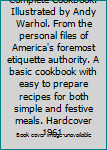Amy Vanderbilt's Complete Cookbook. Illustrated by Andy Warhol. From the personal files of America's foremost etiquette authority. A basic cookbook with easy to prepare recipes for both simple and festive meals. Hardcover 1961.
No Synopsis Available.
Format:Hardcover
Language:English
ISBN:B002ZAYCU2
Release Date:January 1961
Publisher:Doubleday and Company. Garden City, New York.
Weight:1.85 lbs.
Customer Reviews
1 rating
People were afraid of spices in the 50's - 60's...
Published by SharonA , 3 years ago
People were afraid of spices in the 50's - 60's...literally everything in this cookbook reflects that. They were probably quite tasty to the sensitive palates back then...when "Soul food" cooking came upon us (finally) and woke us all up things started taking off as far as cooking with spices goes. I got this book for Warhol's illustrations.





